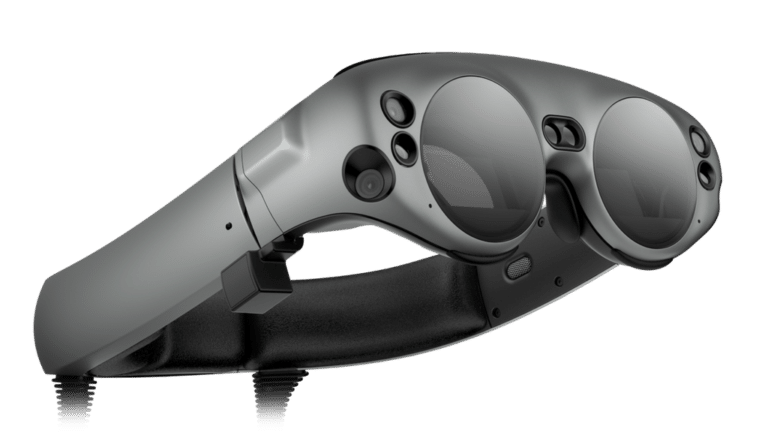
This post is adapted from ARtillry’s latest Intelligence Briefing, AR Business Models: The Top of the Food Chain, Part II. It includes some of its data and takeaways. More can be previewed here and subscribe for the full report.
It’s hard to discuss influential and promising AR players without invoking Magic Leap. The AR innovator has received perhaps more mainstream attention than any other company in this report, partially due to its $2.3 billion in funding and lots of chatter of world-changing optical innovations.
Compared to Microsoft’s HoloLens’ enterprise-focus, Magic Leap is targeting consumer markets. The upside is an eventual market size that exceeds enterprise, though enterprise will scale first. But the downside is that it will butt heads with Apple at some point in that consumer play.
Also like HoloLens (and Apple’s eventual glasses), Magic Leap is vertically integrated and develops the full tech stack for its AR headset. It’s also similar to Microsoft in that it tries to control the language, using terms like “mixed reality.” For consistency, we’ll continue using the term AR.

The Magicverse
Speaking of terminology, Magic Leap recently introduced the term “Magicverse.” A sort of twist on metaverse, it defines Magic Leap’s ideology for how spatial computing will manifest. It’s similar to the AR cloud but with an extra layer of Magic Leap’s principles.
One of the underlying constructs of the Magicverse for example is “verses.” Not a completely new concept, these are data sets that represent thematic layers of content that one might want to see overlaid on their world. There can be layers for entertainment, art, sports, work, utility/safety, etc..
“Maybe there’s going to be a director who creates a week-long comic adventure over Los Angeles,” posed Magic Leap CEO Rony Abovitz at L.E.A.P con. “That may be the entertainment layer. Other folks might want to work on the communication layer or health and wellness layers.”
Furthering the analogy (key root: “analog”), Magic Leap Chief Futurist and Snow Crash author Neil Stephenson invoked a recent lunch where the restaurant had both pleasing decor and eyesores like exit signs. These represent functional layers that could be activated in a Magicverse construct.
“Most of the time you may want to just see the beautiful stuff, but in an emergency, what you want to know is where to find the exits,” he said. “So the idea of layers that serve different purposes that we can toggle on and off as we need them is a key element to the Magicverse concept.”

XR Compatibility
One question this raises is will layers/verses replace the prevailing mobile development platform: apps? That could take a while of course, but there’s growing realization that the siloed app vessel that ruled the smartphone era isn’t optimal for the dynamism required in spatial computing.
Again, lots of these concepts aren’t totally new but Magic Leap’s differentiation comes with full stack orientation, massive funding and technical chops. Its unique take on the AR cloud also boils down to a set of principles for things like cross-platform functionality and decentralization.
“There’s something we think of as ‘XR compatibility,’” said Abovitz. “That means if you build something in Magic Leap, how could it talk to other devices? How could it talk to phones, tablets, or other XR systems so that your work is expressed and amplified in a much greater way.”
As for decentralization, questions of who owns AR content and data continue to be asked. Could the construction of a new system be an opportunity to decentralize? Abovitz thinks so, stressing that Magic Leap isn’t motivated by ad revenue to collect user data.
“There’s thought processes you as creators have to go through: ‘What kind of system do I want to build?’ ‘Who do I want to build it for?’ ‘Who am I building it with?’” he said. “We want it to be distributed, not centrally controlled. We want users to have control over their data.”


Mixed Reviews
The long-awaited release of Magic Leap’s first headset, Magic Leap One, was met with mixed feelings. Interestingly, most negative reviews come from tech publications with non-technical and formal product reviewers. Positive response has come from developers with less “formal” reviews.
We believe this is due to developers’ intimate knowledge of AR’s current deficiencies, which has tempered expectations. Formal reviews from tech writers conversely can’t get past the divergence between two years of hype and what they now perceive as an unspectacular product.
As for common threads across most of the reviews, the field of view is a fairly universal gripe. And the lack of launch content was notable for some, given that there’s only so much that can be done on the device before the app library is exhausted. Then again, this is a developer release.
One of Magic Leap’s challenges is that it’s a victim of the hype that surrounded it — a metaphor for XR’s current stage. Magic Leap One is an impressive piece of technology that’s achieved sizeable technical feats in the past 3-4 years. But has it come short of mind-blowing status?
“I don’t want to condemn it just because it can’t meet the absolutely impossible hype that it’s created. That wouldn’t be fair,” said The Verge’s Adi Robinson in her video review of Magic Leap One. “But Magic Leap just doesn’t have the kind of breakthroughs we’ve all been waiting for.”

The Palm Pilot of AR?
Another challenge that will continue to face Magic Leap is the same challenge we’ve examined for AR experiences in general: you can’t really capture it through 2D video or verbal descriptions. The only way to truly get “sold” on the experience is to try it first-hand, which can be expensive.
This represents a marketing challenge for Magic Leap. In addition to pushing against classic price elasticity — rampant in something that is new/non-vital and pricey — it has to sell new users directly through experience. And that’s a logistical/distribution challenge (think: retail installations).
Marketing challenges aside, Magic Leap One is a key milestone in AR’s evolution. But it shouldn’t be viewed as an end-point; that will only further industry “disillusionment.” If Google Glass was the Apple Newton of AR glasses, could this be the Palm Pilot on the way to the iPhone?
The other question is who will bring us that eventual device? Magic Leap? Apple? It could be some combination if Apple acquires Magic Leap (though ML’s valuation is way outside of Apple’s typical M&A range). Meanwhile, we’ll get lots of good stuff along that evolutionary path.
“The currently available apps don’t use most of the input modalities of the device,” said developer Lucas Rizzotto. “[Its] developer community will outmatch Magic Leap creatively by utilizing everything that’s available, and become the real metric of what this device can do.”
To continue reading, see ARtillry’s latest Intelligence Briefing, AR Business Models: The Top of the Food Chain, Part II.
For deeper XR data and intelligence, join ARtillry PRO and subscribe to the free AR Insider Weekly newsletter.
Disclosure: AR Insider has no financial stake in the companies mentioned in this post, nor received payment for its production. Disclosure and ethics policy can be seen here.
Header Image Credit: Magic Leap
